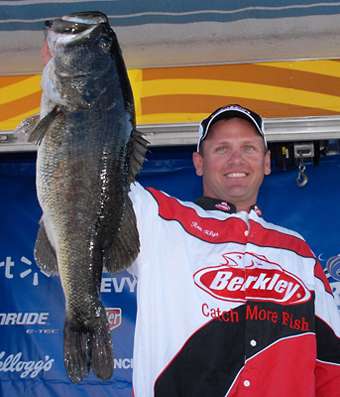
Every day on every lake is different. Techniques that fill your livewell on Monday are worthless on Tuesday. To counter this issue, I've developed several line and lure combinations over the years. They make specific baits act in specific ways. Hopefully they'll help you find the right bite.
Fluorocarbon
1. I always use fluorocarbon line with my Berkley Gulp Sinking Minnows. Fluorocarbon sinks at nearly the same rate as my bait. This keeps it horizontal on the fall, which in turn lets it wiggle and shimmy all the way to the bottom.
2. When I want my drop shot worm to quiver in place, I rig fluorocarbon line to a StandOut Hook and a Berkley Power Finesse Worm. When I tap the top half of my rod with my finger the line transmits an irresistible wiggle down to the bait without moving it forward. This is a solid sight-fishing technique.
3. Fluorocarbon line works great on poppers when you want a soft, gentle action with very little forward movement. It pulls the nose down so that you can dance the bait in place without a lot of splash or popping.
Braid
1. Use braid with topwater lures — usually prop baits — when you want to pull the lure straight forward without even a hint of sideways movement. The unforgiving nature of braid will let you bring your lure back in a perfectly straight line, and it'll help you start and stop your presentation on a dime.
2. Braid is the perfect choice for hard jerkbaits in sparse grass when you want the bait to shoot forward suddenly and without warning. The forward thrust is instant. I don't care how hard you jerk with fluorocarbon or monofilament, you won't get the same action.
3. Combine braid with a fluorocarbon leader for a better feel with your Carolina rig. The Carolina rig is the worst setup on the planet for feeling a bite and knowing where your fish is when you set the hook. This really helps.
Monofilament
1. Mono is great for delaying the hook set when you're fishing crankbaits. It delays the feel just long enough to let the bass get the bait all the way in its mouth. I always use mono when my crankbait bass aren't slamming the lure.
2. Mono is perfect for fishing a soft plastic jerkbait such as a Berkley Hollow Belly Split Tail Minnow over schooling bass. The line stays above the bait as it falls. This allows you to pull the lure toward the surface with a sharp snap of the rod. With a little practice, you can learn to jump the bait out of the water. It'll look exactly like a panicked minnow trying to get away.
3. Use mono when you want the nose of a topwater plug to ride high, above the water's surface. Mono behaves very different than braid in this regard, although both lines will float. To develop a sense of those differences — and a sense of when to take advantage of them — throw two identical lures, one with mono and the other on braid. You'll see exactly what I mean.




